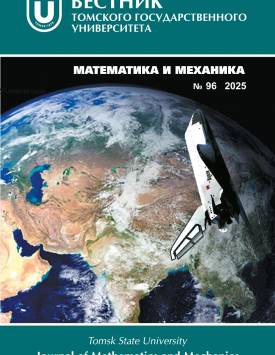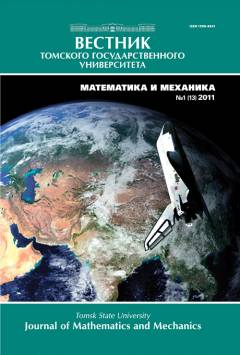Analytical correspondence principle for the elastic and viscoelastic problems
This paper deals with the development of a method for solving the problems of isotropic and anisotropic viscoelastic bodies based on the separation of spatial and temporal variables. In contrast to the classical method of separation of variables implying the transformation of systems of partial differential equations, a specific scheme of transformation of the constitutive equations for a viscoelastic body is proposed. As a result of these transformations, the elastic body equations are obtained, in which some known time functions are used in terms of the material constants of elasticity. First, the constitutive equations of a linear viscoelastic body are considered. Using identical transformations, the equivalence of the constitutive equations for a viscoelastic medium and a comparative elastic medium is proved if the stresses are set at the boundary. In the same manner, the equivalence of viscoelastic and elastic media is proved if the displacements are specified at the boundary. Finally, a relation is identified between the parameters of the comparative elastic media for these two cases, and their mutual converse is justified. The real-problem example is solved and presented at the end of the paper.
Keywords
time-efficient moduli,
identity of constitutive equations,
interchangeability of constitutive equations of elasticity and viscoelasticity,
THE FIRST AND SECOND BOUNDARY-VALUE PROBLEMSAuthors
| Svetashkov Aleksandr A. | Tomsk Polytechnic University | svetashkov@tpu.ru |
| Pavlov Mikhail S. | Tomsk Polytechnic University; Tomsk State University | mspavlov@tpu.ru |
| Pustovykh Ol’ga S. | Tomsk Polytechnic University | BOS1983@tpu.ru |
Всего: 3
References
Maxwell J.C. On the dynamical theory of gases // Philosophical Transactions. 1867. № 157. P. 49-88.
Boltzman L. Zur theorie der elastischen nachwirkung // Wiener Berichte. 1874. № 70. P. 275 doi: 10.1002/andp.18782411107.
Volterra V. Lecons sur les fonctions de lignes. Paris: Gautierr Villars, 1912. 230 p.
Volterra V. Theory of functionals and of integral and integrodifferential equations. London- Glasgow: Blackie & Son Limited, 1930. 226 p.
Алфрей Т. Механические свойства высокополимеров. М.: Изд-во иностр. лит., 1952. 239 с.
Ферри Дж. Вязкоупругие свойства полимеров / пер. с 2-го изд. под ред. В.Е. Гуля. М.: Из-во иностр. лит., 1963. 535 с.
Ржаницын А.Р. Теория ползучести. М.: Стройиздат, 1968. 416 с.
Бленд Д. Теория линейной вязкоупругости // пер. с англ. И.И. Гольберга, Н.И. Малинина; под ред. Э.И. Григолюка. М.: Мир, 1965. 199 с.
Арутюнян Н.Х. Некоторые вопросы теории ползучести. М.; Л.: Гос. изд-во техн.-теорет. лит., 1952. 324 с.
Reddy J.N. An introduction to continuum mechanics. New York: Cambridge University Press, 2008. 449 p.
Pipkin A.C. Lectures of viscoelasticity theory. New York: Springer Verlag, 1986. 181 p.
Flugge W. Viscoelasticity. New York: Blaisdell Press, 1967. 187 p.
Christensen R.M. Theory of viscoelasticity: an introduction. New York: Academic, 1980. 364 p.
Колтунов М.А., Майборода В.П., Зубчанинов В.Г. Прочностные расчеты изделий из полимерных материалов. М.: Высш. школа, 1983. 239 с.
Schapery R.A. Stress analysis of viscoelastic composite materials // Journal of Composite Materials. 1967. V. 1 (3). P. 228-267.
Ильюшин А.А., Победря Б.Е. Основы математической теории термовязкоупругости. М.: Наука, 1970. 280 с.
Бугаков И.И. Ползучесть полимерных материалов (теория и приложения). М.: Наука, 1973. 288 с.
Работнов Ю.Н. Ползучесть элементов конструкций. М.: Наука, 1966. 752 с.
Работнов Ю.Н. Элементы наследственной механики твердых тел. М.: Наука, 1977. 383 с.
Москвитин В.В. Сопротивление вязкоупругих материалов: применительно к зарядам ракетных двигателей на твердом топливе. М.: Наука, Гл. ред. физ.-мат. лит., 1972. 328 с.
Talybly L.Kh., Mamedova M.A. Study on the Method for a Solution to Some Class of Quasi Static Problems in Linear Viscoelasticity Theory, as Applied to Problems of Linear Torsion of a Prismatic Solid // Recent Advances in Mathematical Research and Computer Science / ed. by L.G. Rodino. Book Publisher International, 2021. V. 1. P. 63-72.
Lin C.-Y. Rethinking and researching the physical meaning of the standard linear solid model in viscoelasticity // Mechanics of Advanced Materials and Structures. 2024. V. 31 (11). P. 2370-2385.
Chen G. Recurrent neural networks (RNNs) learn the constitutive law of viscoelasticity // Comput. Mech. 2021. V. 67 (3). P. 1009-1019.
Xu K. et al. Learning viscoelasticity models from indirect data using deep neural networks // Computer Methods in Applied Mechanics and Engineering. 2021. V. 387. Art. 114124.
Ильюшин А.А. Метод аппроксимаций для расчета конструкций по линейной теории термо-вязкоупругости // Механика полимеров. 1968. № 6. С. 210-221.
Малый В.И., Труфанов Н.А. Метод квазиконстантных операторов в теории вязкоупругости анизотропных нестареющих материалов // Известия АН СССР. Механика твердого тела. 1987. № 6. С. 148-154.
Svetashkov A.A., Kupriyanov N.A., Pavlov M.S., Vakurov A.A. Variable separation method for solving boundary value problems of isotropic linearly viscoelastic bodies // Acta Mechanica. 2020. V. 231 (9). С. 3583-3606.
Светашков А.А., Куприянов Н.А., Павлов М.С. Метод разделения переменных для задач линейно вязкоупругого анизотропного тела // Вестник Томского государственного университета. Математика и механика. 2023. № 84. С. 123-138. doi: 10/17223/19988621/84/10.
Svetashkov A., Kupriyanov N., Pavlov M. Generalization of the variable separation method for solving boundary value problems of linear viscoelasticity of kinds I and Ш // Acta Mechanica. 2024. V. 235. P. 1-17.
Светашков А.А. Прикладные задачи механики вязкоупругих материалов. Томск: Изд-во ТПУ, 2012. 205 с.
Дюво Г. Неравенства в механике и физике. М.: Наука, 1980. 384 c.
Колтунов М.А. Ползучесть и релаксация. М.: Высш. школа, 1976. 277 с.

